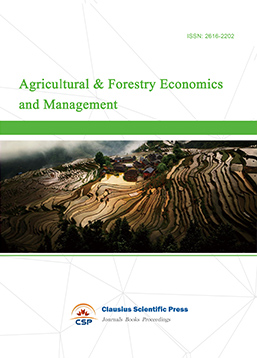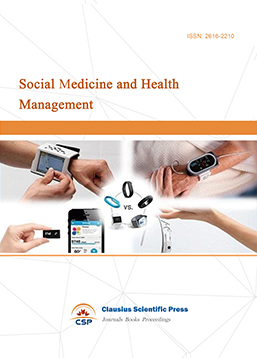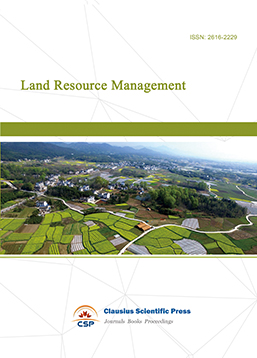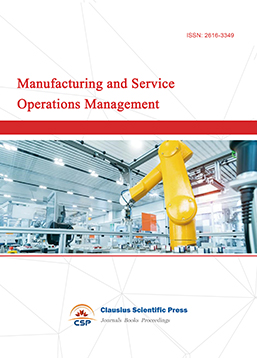The Effect of Organizational Quality Specific Immune on Innovation Performance in Manufacturing Enterprises
DOI: 10.23977/ieim.2020.030108 | Downloads: 51 | Views: 3066
Author(s)
Zhifeng Lian 1, Qiang Liu 2, Yu Guo 3
Affiliation(s)
1 School of Economics, Liaoning University of Technology, Jinzhou, Liaoning, China
2 School of Management, Liaoning University of Technology, Jinzhou, Liaoning, China
3 School of Economics and Management, Harbin Engineering University, Heilongjiang, China
Corresponding Author
Zhifeng LianABSTRACT
Based on the coordination of research issues of organizational quality specific Immune and innovation performance through literature research, this study uses fuzzy set qualitative comparative analysis to evaluate the innovation performance based on product innovation and process innovation from the perspective of organizational quality specific immune. Based on the idea of membership degree, the quantitative components such as comprehensive evaluation value and clustering are added to process the data, finally three paths affecting innovation performance are obtained from the perspective of organizational quality specific immune.
KEYWORDS
Innovation Performance, Organizational Quality Specific Immune, Fuzzy Set Qualitative Comparison AnalysisCITE THIS PAPER
Zhifeng Lian, Qiang Liu, Yu Guo. The Effect of Organizational Quality Specific Immune on Innovation Performance in Manufacturing Enterprises. Industrial Engineering and Innovation Management (2020) 3: 56-68. DOI: http://dx.doi.org/10.23977/ieim.2020.030108.
REFERENCES
[1] Yihua W, Ping L, Bo X, Zhenning Y, Xiaoyang S, Debin D, Zhicheng S. and Xingguo D. (2006) The Study on Organization Immunity. Science of Science and Management of S. & T., 27(6), 135-141.
[2] Liping S, Qiang L, Kangjun W, ZeWen D. (2013) Function Mechanisms of Organizational Quality Specific Immunity Elements Consistency on Quality Performance—Empirical Analysis Based on PP, Fit and Hierarchy Regression Analysis Method. Industrial Engineering and Management, 18 (3), 84-91.
[3] LiPing S, Qiang L, Yanan J, XinQi Y. (2015) Quality Performance Upgrading Paths Optimization Based on Projection Pursuit,RAGA,NK and GERT: Explaining Framework of Setting Organizational Quality Specific Immunity and Product Life Cycle as Main Logic. Operations Research and Management Science, 24(4), 188–97.
[4] LiPing S, Qiang L, Shulin T. (2012) Quality Perfomance Upgrading Paths Based on Organizational Specific Immunity Perspective: Empirical Analysis of Projection Pursuit and Forced Method. Nankai Management Review, 15(6), 123-134.
[5] Heng C, Ruishu X, Yifu L. (2014) Research on Distributed Innovation, Specific Immune and Firm Growth Performance. Science & Technology Progress and Policy, 31(12), 98-104.
[6] Xia Y. (2017) Research on the Current Situation of Technological Innovation Risk Management in Automobile Manufacturing Enterprises in China. Economic Research Guide, (34), 16-17.
[7] Wen Z, Na W. (2017) Research on Performance Improvement Path of Chinese Returnees Enterprises Considering Ambidextrous Network: The Fuzzy-Set Qualitative Comparative Analysis. Science of Science and Management of S.& T., 38(5), 128-139.
[8] Ling L, Shanshan L, Shuqian Z. (2017) A Summary of Research on Enterprise Innovation Performance Index System. New West, (24), 64.
[9] Wei L. (2015) The Reviews and Enlightenment on the Relevance of Marketing Capabilities with Innovation Performance. Science and Technology Management Research, (5), 140-143.
[10] Xianjun L, Ling Z, Jinglun W. and Wei W. (2016) Impact of Open Innovation and Absorptive Capacity on Innovation Performance: An Empirical Analysis of China's Auto Firms. Science Research Management, 36(1), 45-52.
[11] Yuxiao W. (2018) The Influence Mechanism of Multi-dimensional Proximity and Relationship Regulation on Enterprise Innovation Performance in Industry-University-Research Cooperation. Management and Administration, (2), 48-51.
[12] Hui F, Bin H, Qian Z. (2017) Research Review on the Influential Mechanism of Leadership on Creativity and Innovation Performance. East China Economic Management, 31(12), 60-66.
[13] Meng W. (2015) The Role of “Immune System” Theory in Reshaping Corporate Internal Audit Image. Times Finance, (9), 142.
[14] Xiangwu P, Nan W. (2015) Research on Principles and Ability Improving Ways of Immune Response of Enterprises Quality Management. Journal of Chongqing Jiaotong University (Social Sciences Edition), 15 (4), 57-60.
[15] Nan W, Quanxi L. (2015) Empirical Study on Influencing Factors of Enterprise Risk Immune Ability under Immune Recognition Mechanism. Social Science Front, (2), 267-270.
[16] Ping L, Yihua W. (2015) Study on the Behavior and Mechanism of Organizational Immunology. Chinese Journal of Management, 6(5), 607-614.
[17] Tao J, Wei X. (2017) Research on Multilayered Distributed Organization Immune Response Model: An Integrated Perspective. Scientific Management Research, (14), 239-244.
[18] Yongheng X, Yu Z, Zhipeng Z. and Xuetao G. (2018) “Nerve and Immune System” in Enterprises. Manager, (282), 54-59.
[19] Hongyan Z, Shuangxi Y, Chang Y. (2015) Phase Evolution of Absorptive Capacity and Firm Innovation Performance: Empirical Analysis Based on New and High-tech Industries in Shanghai. Foreign Economics & Management, 37(2), 3-17.
[20] Hongtao Y, Pingxiao Y. (2015) Study on the Influence of Openness, Relational Network and Knowledge Sharing on Innovation Performance of Enterprises. Industrial Engineering and Management, (2), 68-73.
[21] Baiyin Y, Ang G. (2013) Identifying Effective Approaches to Innovation Management and Innovative Performance. Science Research Management, 34(3), 41-49.
[22] Daft R L. (1978) A Dual-Core Model of Organizational Innovation. The Academy of Management Journal, 21(2), 193-210.
[23] Damanpour F. (1991) Organizational Innovation: A Meta-Analysis of Effects of Determinants and Moderators. Academy of Management Journal, 34(3), 555-590.
[24] Gopalakrishnan S, Damanpour F. (1997) A Review of Innovation Research in Economics, Sociology and Technology Management. Omega, 25(1), 15-28.
[25] Hongmei Z. (2017) Research on the Influence of Government Support on the Innovation Performance of Manufacturing Enterprises From the Perspective of Open Innovation. Zhejiang Industrial and Commercial University.
[26] Quanxi L, Panshi S, Fenghua J. (2010) Research on Supply Chain Quality Management Model Based on the Perspectives of Immunity. Commercial Research, (7), 72-76.
[27] Hui X, Chunli J, Li J, Bin Z. and Xin J. (2011) Research on the Mechanism of Risk Response of Technology- SMEs Based on the Organizational Immunization Perspective. Management World, (2), 142-154.
[28] Ping L. (2011) An Empirical Study of the Influence Mechanism of Organizational Immune Behavior on Organizational Performance. Science and Science and Technology Management, 32 (7), 15-23.
[29] Ping L, Yihua W. (2009) Organizational Immune Behavior and Research Mechanism. Journal of Management, 6 (5), 607-614.
[30] Walsh J P, Ungson G R. (1991) Organizational Memory. Academy of Management Review, 16(1), 57-91.
[31] Jianbo Z. (2013) The Mechanism of the Impact of Organizational Cognition on Immune Behavior and Organizational Health - A Case Study of A Enterprise. Economic Management, 35(12), 54-64.
[32] Qiang L, LiPing S, Wei C, Yi S. (2016) Identification of Influence Factors of Team Quality Defect Management and the Extraction of Micro and Macro Fuzzy Rules Based on the SYT-FR-CA: Theoretical Framework Based on the Leading Logic of Medical Immunity and Medical Evidence. Industrial Engineering and Management, 21(3), 110-117.
[33] Ping L, Yihua W. (2008) Research on Enterprise Adaptability Based on Organizational Immune Perspective. Scientific Research Management, 29 (1), 164-171.
| Downloads: | 27009 |
|---|---|
| Visits: | 813357 |
Sponsors, Associates, and Links
-
Information Systems and Economics

-
Accounting, Auditing and Finance

-
Tourism Management and Technology Economy

-
Journal of Computational and Financial Econometrics

-
Financial Engineering and Risk Management

-
Accounting and Corporate Management

-
Social Security and Administration Management

-
Population, Resources & Environmental Economics

-
Statistics & Quantitative Economics

-
Agricultural & Forestry Economics and Management

-
Social Medicine and Health Management

-
Land Resource Management

-
Information, Library and Archival Science

-
Journal of Human Resource Development

-
Manufacturing and Service Operations Management

-
Operational Research and Cybernetics


 Download as PDF
Download as PDF